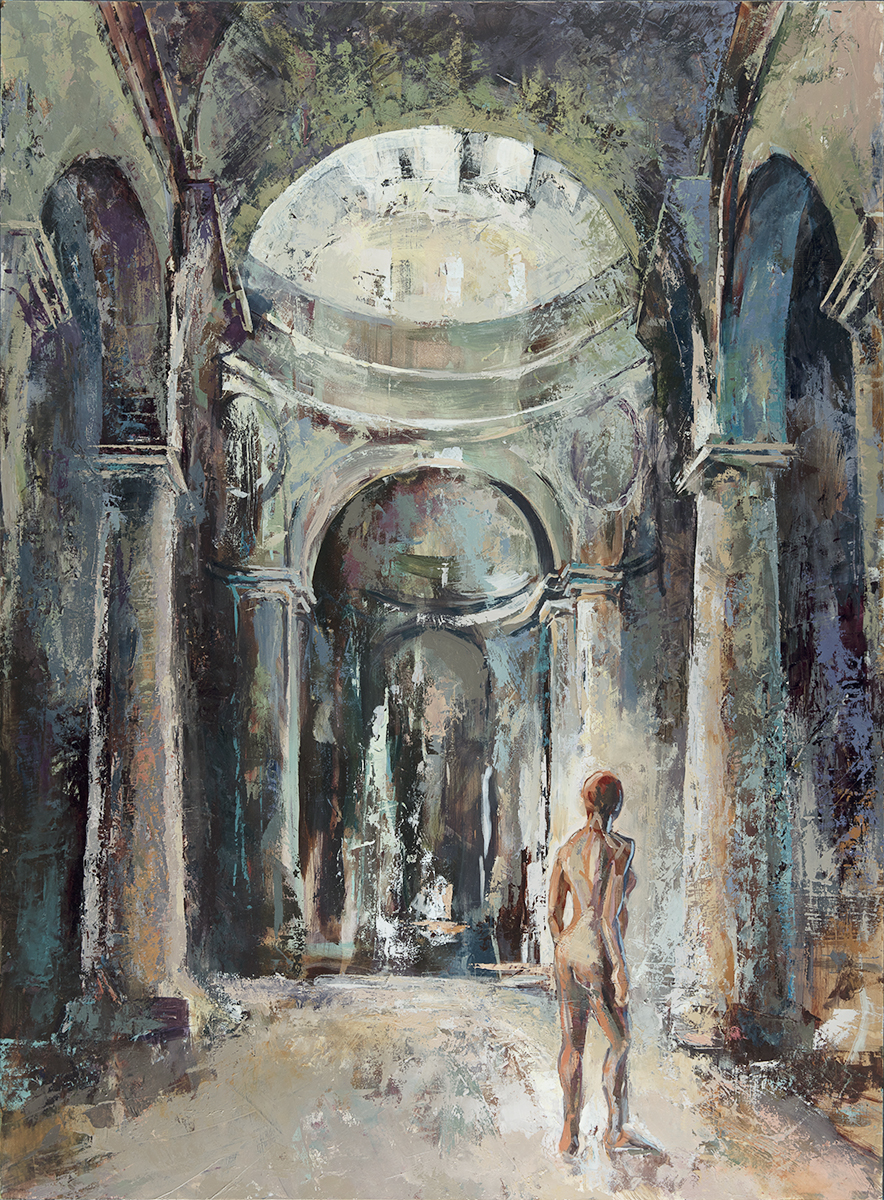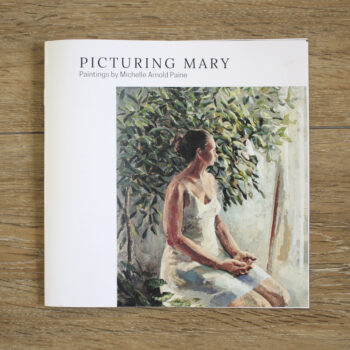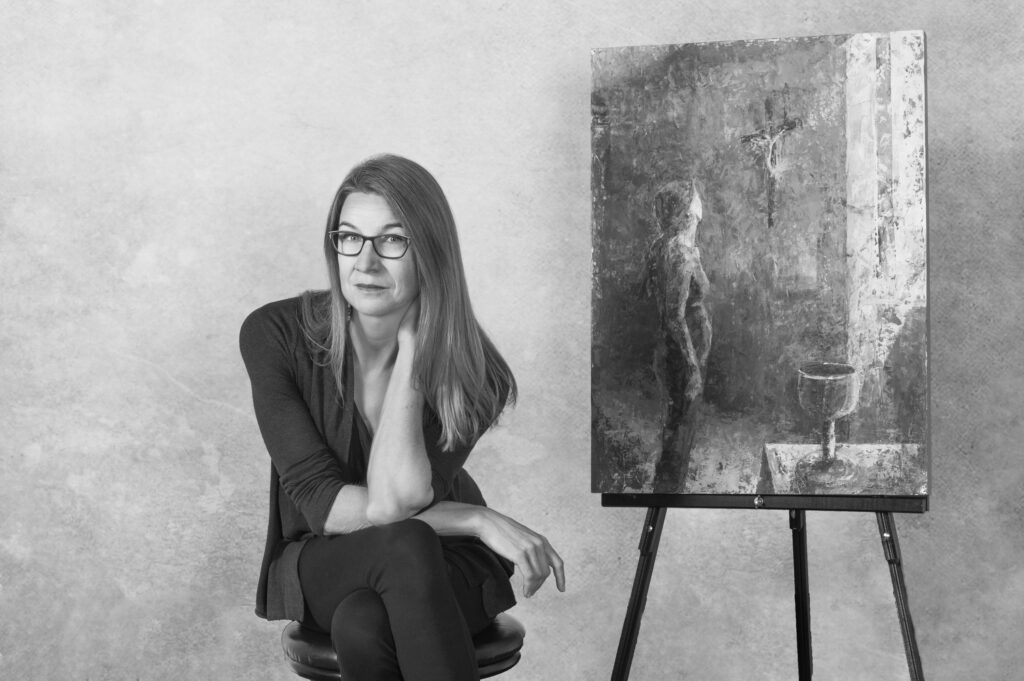New Marian Painting
My newest Marian painting “Interrogatio: Inquiry” depicts that moment of questioning “How can this be?” when the angel announced Christ’s coming to Mary at the Annunciation. Mary’s vulnerability before God is represented here by the nude female figure. In this painting the grand space of the architecture represents God’s overpowering presence. The architecture also becomes a metaphor for Mary herself, often referred to in medieval texts as the Temple or dwelling place of the Lord because of her role in the Incarnation.
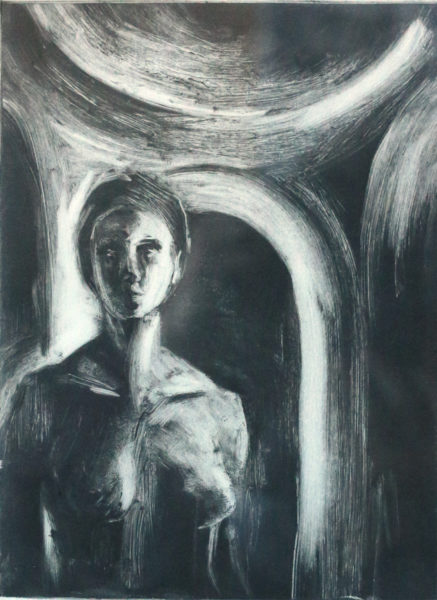
Shrine, Monotype by Michelle Arnold Paine Click to Purchase
Mary the Temple
For more than a decade now I’ve returned over and over to the Marian Hymn “Mary the Dawn”. More recently I have tried to deal with some of the less obvious imagery. It seemed natural to try and combine my figurative works with my church architecture works through exploring these two lines of the hymn:
Mary the Temple, Christ the temple’s Lord;
Mary the Shrine, Christ the God adored.
“Temple” and “Shrine” refer to religious architecture, long my preferred subject matter. Mary was the dwelling place for Jesus before he is born into the world. In that way Mary is similar to the Temple in the Hebrew Bible, in which the Tabernacle is dwelling place of the Lord. For Catholics, the Tabernacle continues to be the dwelling place of God. Jesus, present body and blood in the Eucharist, resides in the Tabernacles of Catholic Churches worldwide.
I began to explore these concepts through monotypes several years ago. What is a monotype? A “hand-pulled print” refers to the traditional printmaking process where a plate is created that can then be rolled through a press multiple times to create multiple images. A monotype uses the same traditional process (an image on a plate, rolled through a press) but it only has one iteration. With an etching, engraving or woodcut, the image remains impressed on the plate and can be inked and run again. In contrast, a monoprint or monotype is a completely unique image. It is more closely related to painting than other forms of printmaking.
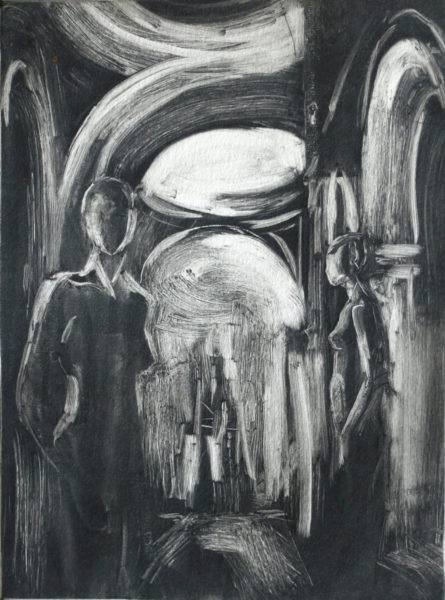
Interrogatio: Inquiry, Monotype on Paper 14″ x 11″ Framed. Click to Purchase.
Other works in my series of Marian paintings have dealt with the images of Mary the Dawn, Mary the Gate, and Mary the Chalice, other lines from the same hymn.
Questioning, Process
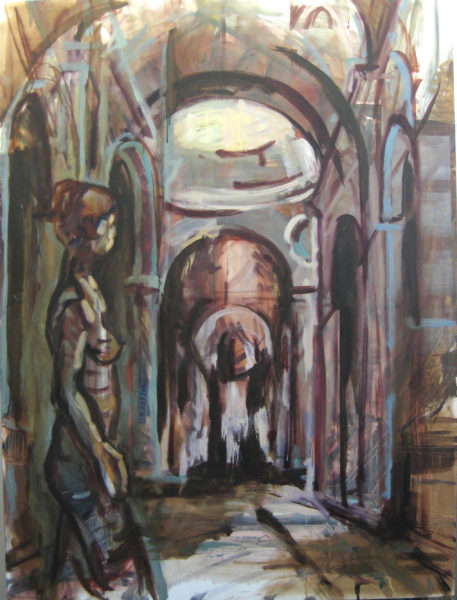 This painting was a struggle. It is one of my first attempts to meld the threads of figuration with architecture in my work. Since I started this painting I’ve had a baby, bought two houses and moved across the country. This in-progress photo demonstrates that the first phase of the painting was modeled more closely on the monotype. In the first phase there was a different figure in the painting, as in the black. I then added a second figure to more closely match the monotype. At a later stage I painted out the first figure and the second, smaller figure remained alone in the painting.
This painting was a struggle. It is one of my first attempts to meld the threads of figuration with architecture in my work. Since I started this painting I’ve had a baby, bought two houses and moved across the country. This in-progress photo demonstrates that the first phase of the painting was modeled more closely on the monotype. In the first phase there was a different figure in the painting, as in the black. I then added a second figure to more closely match the monotype. At a later stage I painted out the first figure and the second, smaller figure remained alone in the painting.
Mary Asks: Interrogatio
The title of the painting comes from a Renaissance text. The more I reflected on the Annunciation and studied Medieval and Renaissance images of the narrative, the more intrigued I was by Mary’s response. Preachers and painters in Medieval/Renaissance Europe worked in tandem to educated the faithful in the narratives of the Bible. In research* I found that preachers in the early Renaissance analyzed the emotional responses of these narratives quite closely into outlines of virtuous and pious behavior. One preacher in Florence under the famous Cosimo de’ Medici outlined five different emotional/spiritual postures after the angel’s greeting to her. These five stages of her response are:
- Conturbatio: Disquiet
- Cogitatio: Reflection
- Interrogatio: Inquiry
- Humilitatio: Submission
- Meritatio: Merit.
These five “Laudable Conditions of the Blessed Virgin” provide me something to latch on to as I seek to grow in my faith and prayer life. As I seek to become intimate with God, these “laudable conditions” provide me with permission to experience the broad range of human emotion and experience . It is too easy to jump to Mary’s “yes” and in the process lose connection, assuming we could attain her level of holiness. These five “conditions” remind us that she (like me) was disrupted, then needed to reflect, then ask questions, before submitting to God’s will.
*from Michael Baxandall’s Painting and Experience in Fifteenth-Century Italy, pp. 48-55.
This painting is included in the Virtual Gallery of the Breath and the Clay conference in March 2021.

